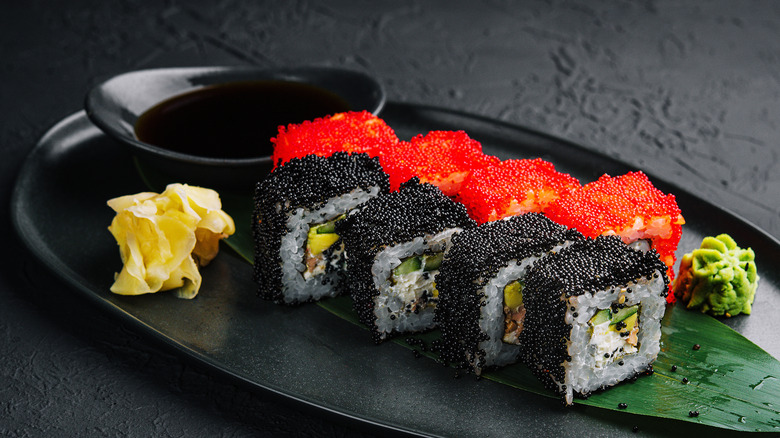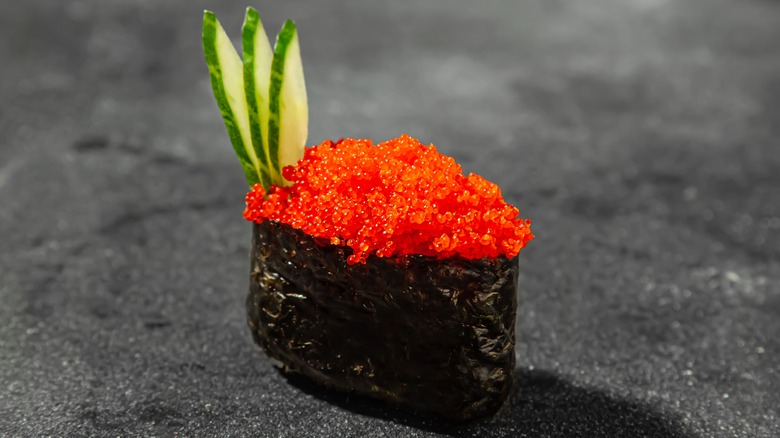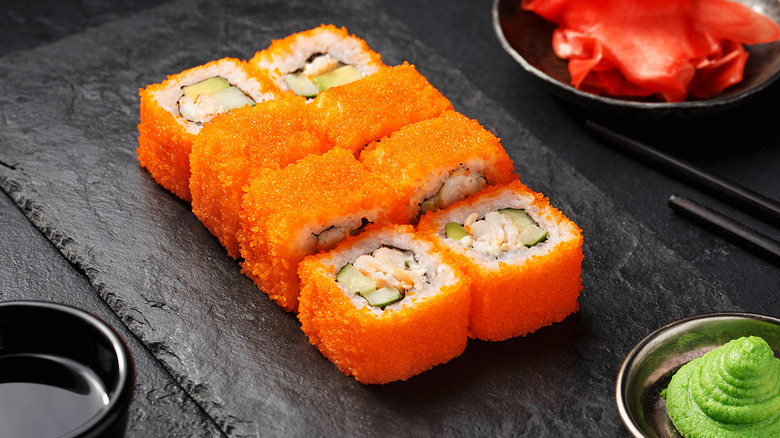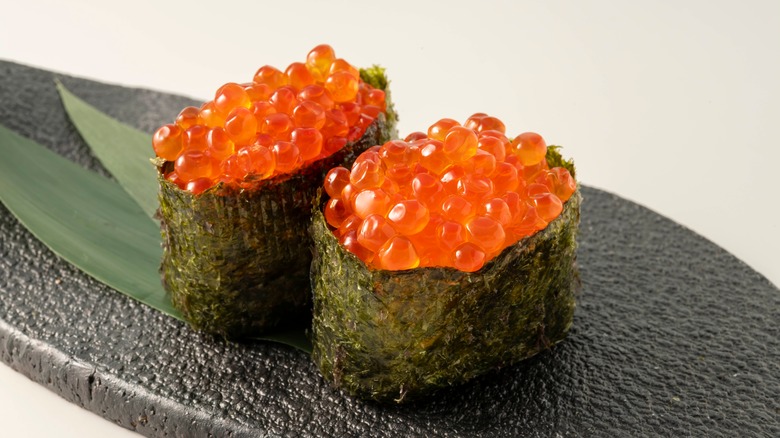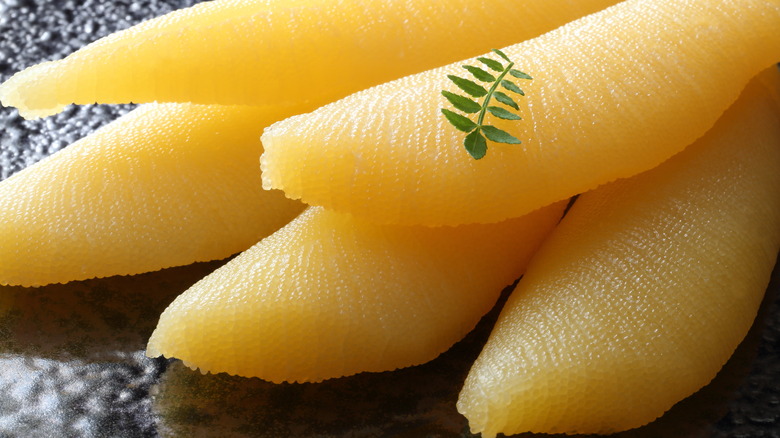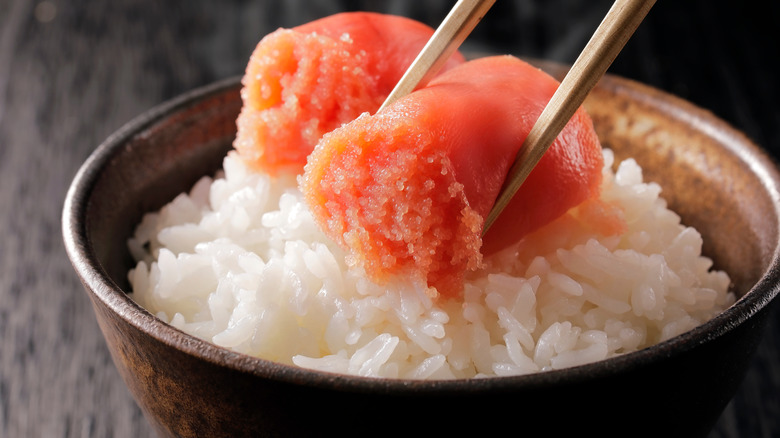What Are The Different Types Of Fish Eggs In Japanese Cuisine?
Sit down for a sushi dinner and chances are you'll encounter some type of fish roe during your meal. Not to be confused with caviar, which comes specifically from only the Acipenseridae family of sturgeons, roe is a catch-all term for ripe and unfertilized fish eggs. While these bright little fish eggs are certainly a delightful treat to look at, they are used for more than just their color in Japanese cuisine. There is bright orange fish roe that brings a crisp texture, and yellow tinted ones that feel firm and rubbery — or those that have a deliciously creamy mouthfeel. Fish roe is even marinated in various dyes and spices to give it both color and a boost of flavor!
Whether enjoyed as a piece of nigiri in the form of a cluster of small eggs sitting atop a clump of rice bound together by seaweed, or sprinkled generously on top of sushi rolls, rice balls, and all sorts of rice or seafood-based dishes, fish roe is more than just a garnish in the Japanese culture — fish roe is an ingredient in its own right.
Tobiko (flying fish roe)
Perhaps the most recognized among the different varieties of fish roe in Japanese cuisine is tobiko or flying fish roe. Tobiko is processed from the unfertilized eggs of flying fish — a species that is known to leap above water and stay in the air for several seconds, giving them the illusion of flying. Although flying fish swims in many waters across the world, tobiko usually comes from the Japanese flying fish, Cheilopogon agoo.
Ranging from 0.5 to 0.8 millimeters in size, tobiko is known for its crunchy texture. Most varieties of tobiko have a reddish-orange hue and a salty, sweet flavor with a hint of smokiness, which they get due to the way they are processed. That said, tobiko can also be infused with other natural ingredients to change its color and flavor. Common variations include tobiko dyed with squid ink to make it look black and to give it a certain umami-ness, yuzu to color it yellow and give its flavor a citrusy brightness, and wasabi to make it green with a sharp and punchy flavor.
There are also varieties of tobiko that are dyed red with beets for a subtly sweet flavor or with chilies for a spicy kick. In addition to adorning maki rolls (such as California rolls), tobiko is often added for its crunch to soft and creamy dishes such as omelets, sushi, sashimi, and nigiri.
Masago (smelt roe)
Often confused with tobiko by the untrained eye, masago consists of eggs from the capelin, a fish the size of a sardine in the smelt family. While capelin can be found across the Pacific, North Atlantic, and North Pacific Oceans, the masago used in Japanese cuisine comes from a type of capelin known as shishamo that is native to Hokkaido, Japan's northernmost island. Masago eggs are visibly smaller than tobiko, with a fine and sandy appearance. The mouthfeel is somewhat different too — where tobiko has that crunch and pop that is expected from fish roe, masago is not as pleasantly crunchy and has a significantly softer texture.
Masago can also be slightly more bitter than tobiko and is known to be on the very other end of the spectrum compared to caviar in terms of its quality and price tag (tobiko generally stands in between masago and caviar). Much like tobiko, masago can also be dyed, but it's not so much for flavor as it is to mask its dull pale-yellow color. While masago too is eaten on top of various kinds of sushi, it is famously turned into a sauce along with Kewpie mayonnaise and sriracha, which is served alongside grilled seafood and plates of sushi.
Ikura (salmon roe)
Together with tobiko and masago, ikura (or salmon roe) make up the main three fish roe that are staples of Japanese cuisine. Despite its popularity, however, ikura is only a recent addition to sushi and other dishes. In fact, ikura is often imported into the country — having been incorporated into Japanese cuisine in the late 20th century. Regardless, ikura has an important place in Japanese culture where it is often referred to as Japanese caviar or red caviar for its high quality, taste, and steep price tag.
Though the three types of fish roe may all look similar at first, ikura is notably larger than both tobiko and masago with an orange hue, a burst of umami flavor, and a plump texture that has more of a pop rather than a crunch. Ikura is also gooey in texture and quite delicate — handle an egg with a little too much force, and you risk puncturing it and spilling the briny, slightly sweet liquid inside everywhere.
Though most often consumed while wrapped in crisp seaweed on top of sushi rice, ikura can also be enjoyed as sashimi, and it's the only one of these three types of roe to have a culinary presence outside of Japanese cuisine (especially in Russia). Salmon roe can be substituted in lieu of more traditional — and extravagantly expensive — black caviar, and it is served with blinis and sour cream in several countries, including the U.S.
Kazunoko (herring roe)
Kazunoko is unlike any other fish roe used in Japanese cuisine in that — while those like tobiko, masago, and ikura are comprised of individual balls of fish eggs — kazunoko is more like a lump where a multitude of herring eggs are tightly clumped together. Golden yellow in color with a texture that is kori kori (aka crunchy) as the Japanese say, kazunoko has an important place in Japanese cuisine.
Kazunoko is an integral part of osechi ryori, or Japanese New Year foods, along with the likes of kuromame (sweet black soybeans) and tazukuri (candied anchovies). Like each osechi ryori dish, kazunoko also has great symbolic significance: The fish roe represents fertility.
Kazunoko gets its name from the Japanese word kazu for numbers and ko for children, making the fish roe a symbol of an abundance of children and a prosperous family in the year to come. Kazunoko is typically eaten cold after its membrane is removed and the clusters of roe have been soaked in a soy sauce and dashi mixture, which gives it a salty, savory, umami flavor.
Tarako and mentaiko (cod or pollock roe)
Tarako gets its name from the words tara for cod and ko for children, essentially translating to children of the cod. Both tarako and mentaiko are cod roe; tarako refers to plain, salted fish eggs with a pinkish-beige hue, but mentaiko goes one step further: It is the same salted cod roe, but the roe is marinated in spices such as powdered chilies and togarashi (a Japanese spice blend) to give it a brighter color and a spicier, more umami-rich flavor.
Much like ikura, while mentaiko now has a quintessential place in Japanese culture (Japan's Fukuoka city is known as the mentaiko capital of the world!), its roots lay elsewhere. Mentaiko is a descendant of Korean myeongnanjeot — fermented pollock roe made with gochugaru instead of togarashi — which made its way to Japan after the country occupied Korea during World War II. In Japan, tarako and mentaiko are both loved for a saline flavor that isn't overly fishy, as well as a soft and creamy texture. While both types of cod roe can be eaten raw or topped onto sushi, they are often stuffed inside seaweed-wrapped onigiri rice balls or served on top of steaming mountains of rice with green tea broth in a dish known as chazuke. Mentaiko is also popular in a wafu-style (Japanese fusion) pasta dish where it is combined with soy sauce, butter, and cream to make a rich, spicy, and utterly delicious plate of spaghetti.

